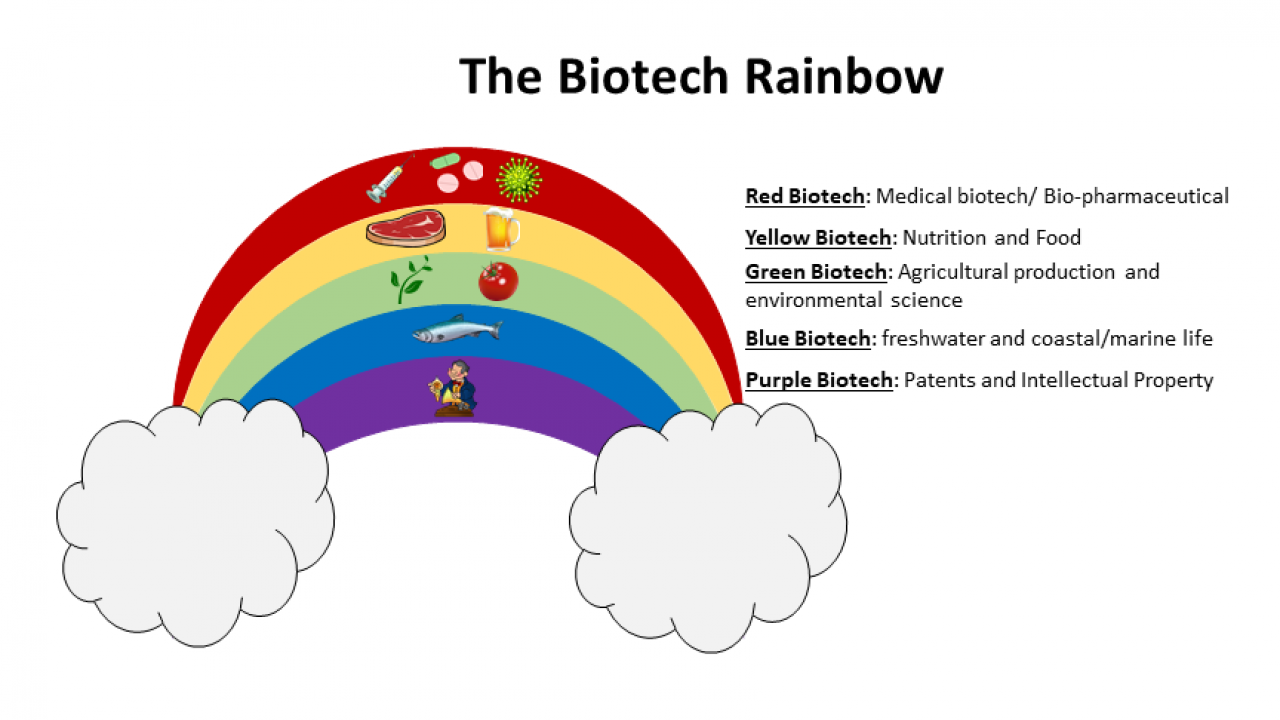
The Biotechnology Rainbow
The Biotechnology Rainbow
by Tawni Bull
When you see a rainbow what is your first thought? Maybe it’s about how much you like rain, or how there may be a pot of gold at the end of it, or maybe something else. Whatever your thought, I can almost guarantee you do not think of the diverse branch of science we call biotechnology. Biotechnology is a word we hear quite often, but what it is it really? If you were to look up the definition you would see that it is “the area of biology that uses living processes, organisms, or systems to manufacture products or technology intended to improve the quality of human life.” In other words, biotechnology, biotech for short, is a branch of science that combines multiple disciplines to develop technology for improved life. Now, you may be wondering why I am comparing a rainbow to biotech? Like I mentioned above, biotech is VERY diverse! So diverse, in fact, we have named different branches using different colors: red, yellow, blue, green, and purple/violet. OK, I know I am missing some colors from the rainbow, but five out of seven is still the majority.
Let’s briefly dive into this world of colors:
- Red Biotech: This branch of biotech is also known as medical biotech or bio-pharmaceutical and it focuses on the production of medicines, vaccines, and drugs to help prevent and/or cure diseases. This branch has become a large factor in clinical research and gene therapy. Current clinical trials are using viruses to deliver genes for gene therapy against diseases such as congenital blindness and non-Hodgkin lymphoma. There is more information about this technology here.
- Yellow Biotech: This is where we focus on food biotechnology and nutrition science. The overall goal of yellow biotech is to make food “better” and to grow food more sustainably. A popular example within this color, utilizing the power of fermentation, is the art of brewing beer. Another interesting example, as discussed by Sharma et al. (2015) is the production of meat using in vitro cell culture.
- Blue Biotech: Blue biotech is large branch that consists of aquaculture, coastal and marine life. Applications of this branch include increasing food supply from freshwater fish and seafood and the development of alternative energy sources. A product of blue biotech is the AquAdvantage salmon. This genetically engineered salmon contains foreign genes that allow it to grow year-round and was approved for sale and consumption by the FDA in 2015.
- Green Biotech: Here we have the plants (my favorite). The branch focuses mainly on the sustainable production of agricultural crops and improvement through genetic engineering. Improvement can refer to quantity (yield) and/or quality (shelf-life, flavor, etc.) of food. A famous green biotech product brought to the market in 1994 was the Flavr Savr tomato. This tomato was engineered to withstand the rigors of shipping and have an increased shelf life.
- Purple/Violet Biotech: Purple biotech is the legal branch that encompasses patents, publications, and intellectual property. While all other branches of biotech work toward the development and production of new technologies, purple biotech is the branch that maintains and files each invention and patent.

In the biotech industry, there are more colors to the rainbow, but the ones discussed above covered most of them. Another interesting thing: each color can collaborate with any of the other colors. Like I mention, plants are my favorite. So as an example, aspects of green biotech can be found intertwined with every other color of the biotech industry. Pretty cool, right? What is your favorite color? I bet there is a little bit of your color in each branch of biotech.
Whatever your favorite branch of science, or your favorite color, I hope the next time you see a rainbow you remember the vast and intriguing world that is the biotech industry.
References
- Bloch, S. (2019). “AquAdvantage, the first GMO salmon, is coming to America.” https://thecounter.org/fda-aquabounty-gmo-salmon-seafood-restriction-market/
- Bruening, G. and Lyons, J.M. The case of the FLAVR SAVR tomato. California Agriculture. 54:4.
- DaSilva, E.J. (2004). The Colours of Biotechnology: Science, Development and Humankind. Electronic Journal of Biotechnology. 7:3.
- Sharma, S. et al. (2015). In vitro meat production system: why and how? Journal of Food Science and Technology. 52, 7599-7607.
- Shirley, J.L. et al. (2020). Immune Responses to Viral Gene Therapy Vectors. Molecular Therapy. 28:3, 709-722.
Editor's Note
This introductory blog is the first in a series about biotechnology that has been crafted by Tawni Bull for middle school science students and educators, as well as non-specialist audiences. She has research expertise in plant-pathogen interactions, molecular biology and genomics through her work in the Michelmore Lab at the UC Davis Genome Center. Other blogs in the series include:
- Red Meets Green Biotech: Plants in Medicine (September 15, 2020)
- Blue Meets Green Biotech: Plants in Water (January 19, 2021)
- Green Biotech: Methods of Genetic Engineering in Plants (February 24, 2021)
- What Do You Know About Bioengineered Crops (a.k.a. GMO's)? (March 29, 2021)
